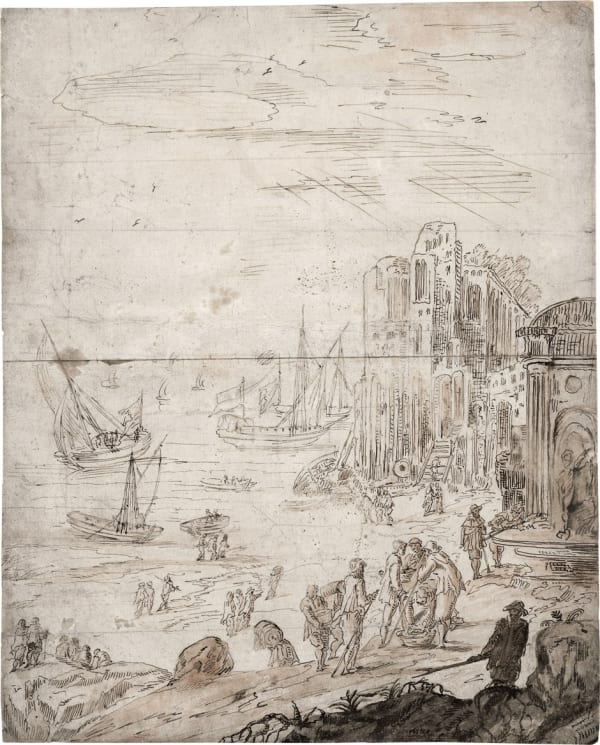-
 Jan Baptist Xavery (Antwerp 1697 - 1742 The Hague)Bacchus & Pan, ca. 1730boxwoodheight 23,5 cmPan signed 'I.B.X', on the belt
Jan Baptist Xavery (Antwerp 1697 - 1742 The Hague)Bacchus & Pan, ca. 1730boxwoodheight 23,5 cmPan signed 'I.B.X', on the belt -
-
VANITAS ET VERITAS
"Vanitas vanitatum, omnia vanitas."
The theme of vanity, highlighting the transient nature of life and the certainty of death, was a common topos in medieval, renaissance and baroque art. Whether explicitly - sculpted or drawn human skulls - or more subtly - works symbolizing the passing of time - many works of art of the period intended to instill the viewer with a sense of "memento mori". A gentle reminder that, as all things come to pass, so shall you.
-
-
 Memento Mori: A German 17th-century Ivory Skull, ca. 1650
Memento Mori: A German 17th-century Ivory Skull, ca. 1650 -
 Andreas Vogler (Augsburg ca. 1730 - 1800), A Portable Equatorial Sundial, ca. 1775
Andreas Vogler (Augsburg ca. 1730 - 1800), A Portable Equatorial Sundial, ca. 1775 -
 Maximilien Louis van Lede (Bruges 1759 - 1834), An Allegory of Truth, 1781
Maximilien Louis van Lede (Bruges 1759 - 1834), An Allegory of Truth, 1781 -
 Isaac Wigans (Antwerp 1615 - ca. 1663), A still life with a silver tazza, a pie, a peeled lemon, a flute glass, a goblet and an earthenware jug, all on a draped table, ca. 1645
Isaac Wigans (Antwerp 1615 - ca. 1663), A still life with a silver tazza, a pie, a peeled lemon, a flute glass, a goblet and an earthenware jug, all on a draped table, ca. 1645 -
 Memento Mori: A German 17th-century Vanitas Study of a Skull, ca. 1600
Memento Mori: A German 17th-century Vanitas Study of a Skull, ca. 1600 -
 Michiel van der Voort the Elder (Antwerp 1667 - 1737), A large-scale Modello of a Mourner, probably for a Funerary Monument, ca. 1710
Michiel van der Voort the Elder (Antwerp 1667 - 1737), A large-scale Modello of a Mourner, probably for a Funerary Monument, ca. 1710
-
-
 Philips Galle (Haarlem 1537 - 1612 Antwerp) after Pieter Bruegel the Elder (Antwerp? ca. 1525 - 1569 Brussels)Caritas: One of the Seven Virtues, 1559engraving on laid paper224 x 291 mm (trimmed to platemark)only state, 16th century impressionsigned and dated 'Bruegel 1559', lower right
Philips Galle (Haarlem 1537 - 1612 Antwerp) after Pieter Bruegel the Elder (Antwerp? ca. 1525 - 1569 Brussels)Caritas: One of the Seven Virtues, 1559engraving on laid paper224 x 291 mm (trimmed to platemark)only state, 16th century impressionsigned and dated 'Bruegel 1559', lower right -
CORNUCOPIA
Antwerp was an important trading centre - note the drawing depicting the hustle and bustle of the Antwerp harbour - as well as a veritable hotbed of artistic activity and innovation, where works of art were produced and sold or exported to all corners of the known world. The artists of the Antwerp baroque were interested in a broad range of subjects, spurred on by a wealthy and educated local clientele that avidly collected a range of genres, anything from lofty mythological subjects to ponder and comment in the company of one's intellectual friends to quaint village harvest scenes or forest landscapes that were a sight and a delight for the city dwellers' sore eyes. Artists like Jordaens portrayed ordinary men and women, while Rubens (whose presence is suggested here by works from his journeymen Cornelis Schut and Victor Wolfvoet) and his ilk instinctively favoured the grand and the monumental.
-
TOWN AND COUNTRY
-
GODS AND MEN
-
T R E A S U R E S: New Acquisitions & Old Friends
Current viewing_room






















